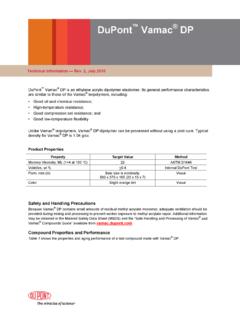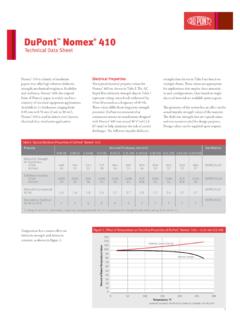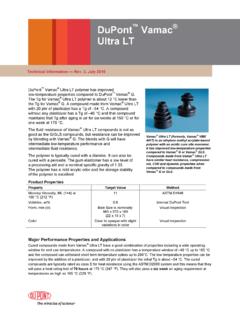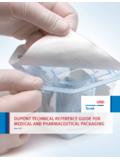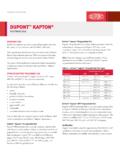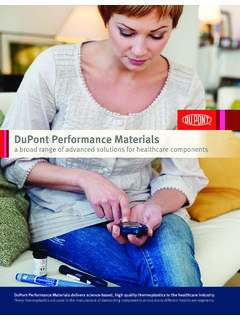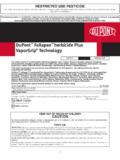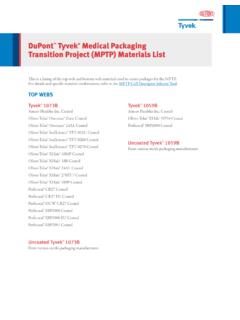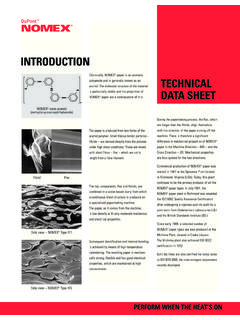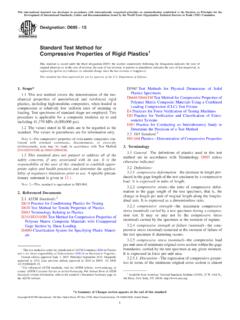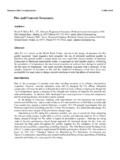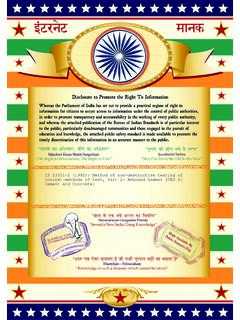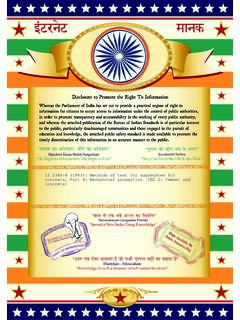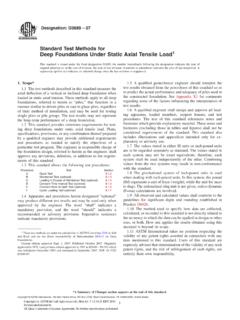Transcription of DuPont Styrofoam Brand Highload 40, 60 and 100 XPS Foam ...
1 DuPont Styrofoam Brand Highload 40, 60 and 100 XPS Foam Insulation Tough, Versatile Insulation for Commercial High-Load, Low-Temp and Geotechnical ApplicationsProduct Information SheetFEATURES/BENEFITSD escriptionDuPont Styrofoam Brand Highload Extruded Polystyrene (XPS) Foam Insulation* is a closed-cell foam insulation designed for use in low-temperature (freezer floor) applications, highways, airport runways, bridge abutments, parking decks, utility lines, ice rinks and plaza decks. Available in compressive strengths of 40, 60 and 100 psi (275, 415 and 690 kPa), Styrofoam Brand Highload Insulation features exceptional moisture resistance and R-value** retention.
2 All three Styrofoam Brand Highload products resist compressive creep and fatigue, delivering long-term compressive strength. Like all Styrofoam Brand insulation products, Styrofoam Brand Highload 40, 60 and 100 are durable, versatile and reusable making them a preferred choice for a variety of high-load of UseStyrofoam Brand Highload Insulation comes in three different compressive strengths to fit any application. Styrofoam Brand Highload : Provides superior resistance to water absorption, water vapor transmission and freeze thaw cycling Can be used in low-temperature, geotechnical, high-load commercial and other in-ground applications Delivers long-term compressive strength in high-load applications Features exceptional R-value retention Resists compressive creep and fatigue * Styrofoam Brand Highload Extruded Polystyrene Foam Insulation is a former product of The Dow Chemical Company.
3 ** R means resistance to heat flow. The higher the R-value or RSI, the greater the insulating Styrofoam Brand Highload Insulation products exhibit the typical physical properties indicated in Tables 1 and 2 when tested as represented. Review all instructions and (Material) Safety Data Sheet ((M)SDS) before use. Please contact DuPont at 1-866-583-2583 when additional guidance is required for writing specifications that include this SolutionsStyrofoam Brand Highload Insulation uses BluEdge technology.
4 It is hydrochlorofluorocarbon (HCFC) free with zero ozone depletion potential and is reusable in many 1: Typical Physical properties of Styrofoam Brand Highload 40, 60 and 100 XPS Foam Insulation Property and Test MethodHighload40 Highload60 Highload100 Thermal Resistance, per inch, ASTM C518, C177, @ 75 F mean temp.,ft2 h F/Btu, R-value, Strength(1), ASTM D1621, psi, Absorption, ASTM C272, % by volume, max. (24 hr water immersion) Vapor Permeance(2), ASTM E96, ( ) ( ) ( )Maximum Use Temperature, F165165165 Coefficient of Linear Thermal Expansion, ASTM D696, in/in x x x 10-5 Flexural Strength, ASTM C203, psi, Modulus (typical), ASTM D 1621, psi (kPa)1,400(9,650)2,200(15,170)3,700(25,5 10)Complies with ASTM C578, TypeVIVIIV.
5 (1) Vertical compressive strength is measured at 5 percent deformation or at yield, whichever occurs first. Since Styrofoam insulations are visco-elastic materials, adequate design safety factors should be used to prevent long-term creep. For static loads, 3:1 is suggested. For dynamic loads, call 1-866-583-2583 for safety factor recommendation.(2) Water vapor permeance varies with product type and thickness. Values are based on the desiccant method and they apply to insulation 1 or greater in thickness.
6 (3) These numerical flame-spread and smoke-developed ratings are not intended to reflect hazards presented by this or any other material under actual fire condition. Refer to UL for details on foam thickness and maximum density 2: Canadian Typical Physical properties of Styrofoam Brand Highload 40, 60 and 100 XPS Foam Insulation Property and Test MethodHighload40 Highload60 Highload100 Thermal Resistance, per inch (25 mm), ASTM C518, C177, @ 75 F(24 C) mean temp., ft2 h F/Btu (m2 C/W), R-value (RSI), (.)
7 88) (.88) (.88) compressive Strength(1), ASTM D1621, psi (kPa), (275)60 (415)100 (690)Water Absorption, ASTM D2842, % by volume, max. (96 hr water immersion) Vapour Permeance(2), ASTM E96, perms (ng/Pa s m2) ( ) ( ) ( )Maximum Use Temperature, F165 (74)165 (74)165 (74)Coefficient of Linear Thermal Expansion, ASTM D696, mm/m-C (in/in F) x 10-5( x 10-2) x 10-5( x 10-2) x 10-5( x 10-2)Flexural Strength, ASTM C203, psi, (480)85 (585)100 (585) compressive Modulus (typical), ASTM D 1621, psi (kPa)1,400(9,650)2,200(15,170)3,700(25,5 10)
8 Complies with CAN/ULC S701, Type444 Surface Burning Characteristics, CAN/ULC for both foam core and finished product3 Flame SpreadSmoke Developed<300<700<300<700<300<7001 Vertical compressive strength is measured at 5 percent deformation or at yield, whichever occurs first. Since Styrofoam insulations are visco-elastic materials, adequate design safety factors should be used to prevent long-term creep. For static loads, 3:1 is suggested. For dynamic loads, call 1-866-583-2583 for safety factor Water vapour permeance varies with product type and thickness.
9 Values are based on the desiccant method and they apply to insulation 1 (25 mm) or greater in thickness3 Tested per CAN/ULC Refer to UL and CCMC listings for details on foam thickness and maximum density standards DuPont Styrofoam Brand Highload Extruded Polystyrene (XPS) Foam Insulation meets ASTM C578 Standard Specification for Rigid Cellular Polystyrene Thermal Insulation. Applicable ASTM standards include: C518 standard test method for Steady-State Thermal Transmission properties by Means of the Heat Flow Meter Apparatus C177 standard test method for Steady- State Heat Flux Measurements and Thermal Transmission properties by Means of the Guarded-Hot-Plate Apparatus D1621 standard test method for compressive properties of Rigid Cellular Plastics D2842 standard test method for Water Absorption of Rigid Cellular Plastics E96 Standard Test methods for Water Vapor Transmission of Materials
10 C272 - standard test method for Water Absorption of Core Materials for Structural Sandwich Constructions D696 standard test method for Coefficient of Linear Thermal Expansion of Plastics Between -30 C and 30 C With a Vitreous Silica Dilatometer C203 Standard Test methods for Breaking Load and Flexural properties of Block-Type Thermal Insulation Cellular Plastics D4716 standard test method for Determining the (In-plane) Flow Rate per Unit Width and Hydraulic Transmissivity of a Geosynthetic Using a Constant Head CAN/ULC S701 Type 4 NoticeStyrofoam Brand Highload Insulation complies with the following codes: International Residential Code (IRC) and International Building Code (IBC); see ICC-ES ESR 2142 (excluding Styrofoam Highload 100) California Std.
